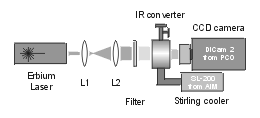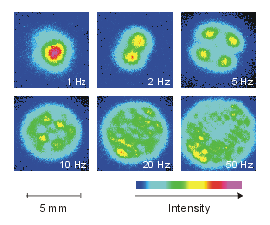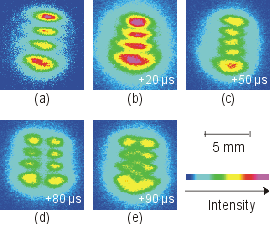
Mode evolution of erbium laser
Erbium lasers are for medical applications of particular interest. For example these lasers are used as treatment of cataract in the ophthalmology. The mode profile is for special interest for developer of these lasers. Due to short laser pulses ( 50 up to 500 ms) and wavelength (about 3 µm) there does not exist a satisfying method for fast spatial resolved image acquisition.
The set-up of the experiments is shown in the following figure.

Figure of experimental
set-up for mode evolution of erbium lasers.
The laser beam is projected to the input window of the IR converter. The glow of the gas discharge is recorded by an intensified CCD camera.

Dependency on
mode profile and repetition rate.
The series of images shows evolution of laser beam profile depending on repetition rate. By increasing frequency higher modes are excited. The following example shows temporal evolution of profile at a fixed repetition rate.

Temporal evolution
of mode profile. Image (a) is picture
of total laser beam pulse (exposure time 200 µs); (b) to (e) are
images with exposure time of 10 µs taken at the indicated time.
The omplete pulse (a) consists of mode profile with four stripes. The internal dynamical behaviour of the laser beam can be resolved by applying shorter exposure time.
Thes results demonstrate the potential use of the IR converter for studying mode evolution of IR lasers.